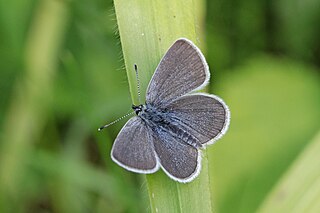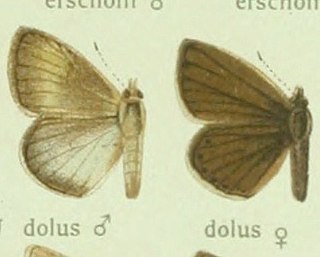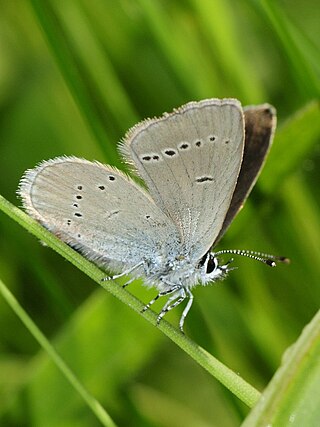
The common blue butterfly or European common blue is a butterfly in the family Lycaenidae and subfamily Polyommatinae. The butterfly is found throughout the Palearctic and has been introduced to North America. Butterflies in the Polyommatinae are collectively called blues, from the coloring of the wings. Common blue males usually have wings that are blue above with a black-brown border and a white fringe. The females are usually brown above with a blue dusting and orange spots.

Lycaenidae is the second-largest family of butterflies, with over 6,000 species worldwide, whose members are also called gossamer-winged butterflies. They constitute about 30% of the known butterfly species.

The small blue is a Palearctic butterfly in the family Lycaenidae. Despite its common name, it is not particularly blue. The male has some bluish suffusion at the base of its upper wings but is mostly dark brown like the female. The species can live in colonies of up to several hundred and in its caterpillar stage is cannibalistic.

The short-tailed blue or tailed Cupid is a butterfly that forms part of the family Lycaenidae. It is found from Europe to Japan and in India.

Lampides boeticus, the pea blue, or long-tailed blue, is a small butterfly that belongs to the lycaenids or gossamer-winged family.

The eastern tailed-blue or eastern tailed blue, also known as Everes comyntas, is a common butterfly of eastern North America. It is a small butterfly that is distinguished from other blues in its range by the small thin tail.

Leptotes pirithous, commonly known as Lang's short-tailed blue or common zebra blue, is a butterfly of the family Lycaenidae.

Cupido is a genus of butterflies in the family Lycaenidae. The subgenus Everes is included here.

Cupido alcetas, the Provençal short-tailed blue, is a small butterfly that belongs to the family Lycaenidae.

Glaucopsyche lygdamus, the silvery blue, is a small butterfly native to North America.

Polyommatus dolus, the furry blue, is a butterfly of the family Lycaenidae. It is found in Spain, in France and Italy.

The Osiris blue is a butterfly in the family Lycaenidae. It is found in South Europe, Asia Minor, southern Siberia, the Alay Mountains, Tian-Shan, Dzhungarsky Alatau, the Altai Region, the Sayan mountains, Lake Baikal and Mongolia. It is often confused with the small blue, a closely related species.












